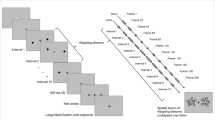Abstract
The changes in perception associated with exposure time are probably continuous in the microgenetic process, as is demonstrated by such phenomena as intensity change in illusions, adaptation and normalization, practice effect, aftereffects, etc. The simultaneous contrast and assimilation in the perception of length of paired lines were measured by controlling the exposure duration or repetition. In the tachistoscopic experiment, the greatest contrast appeared at an early stage of microgenesis. In the repeated presentation experiment, the perception changed from contrast to assimilation on the expanded stage of microgenesis. These changes in perception are assumed to be the results of the differentiation of set that progresses in the microgenetic process. In the fixed-set experiment, the differentiation of set was reflected in the intensity of the aftereffect. The changes in the aftereffect and the transformation into the assimilation coincided with each other when the exposure time was varied. An expansion of the conception of perceptual microgenesis to a wider range of perceptual variability is accordingly proposed.
Similar content being viewed by others
References
Bachmann, T. (1987). Different trends in perceptual pattern microgenesis as a function of the spatial range of local brightness averaging: Towards an empirical method for the differentiation between global and local levels form as related to processing in real time.Psychological Research, 49, 107–111.
Brown, J. W. (1988).The life of mind: Selected papers. Hillsdale, N. J: Lawrence Erlbaum Associates.
Draguns, J. G. (1986). Subliminal perception as the first stage of perception: Can personality be revealed so early in the sequence? In G. Smith, U. Hentschel, & J. Draguns (Eds.),The roots of perception. Amsterdam: Elsevier.
Flavell, J. H., & Draguns, J. (1957). A microgenetic approach to perception and thought.Psychological Bulletin, 54, 197–217.
Fröhlich, W. D. (1984). Microgenesis as a functional approach to information processing through search. In W. D. Fröhlich, G. Smith, J. G. Draguns, & U. Hentschel (Eds.),Psychological processes in cognition and personality. Washington, DC: Hemisphere.
Gibson, J. J. (1933). Adaptation, after-effect and contrast in the perception of curved lines.Journal of Experimental Psychology,16, 1–31.
Gibson, J. J. (1937a). Adaptation, after-effect and contrast in the perception of titled lines, II: Simultaneous contrast and the areal restriction of the after-effect.Journal of Experimental Psychology, 20, 553–569.
Gibson, J. J. (1937b). Adaptation with negative after-effect.Psychological Review, 44, 222–244.
Hanlon, R. E. (Ed.) (1991).Cognitive microgenesis: A neuropsychological perspective. New York: Springer-Verlag.
Helson H. (1964).Adaptation-level theory. New York: Harper & Low.
Kragh, U., & Smith, G. (1970).Percept-genetic analysis. Lund, Sweden: Gleerups.
Nakatani, K. (1985). Application of the method of fixed set to the size-weight illusion.Psychological Research, 47, 223–233.
Nakatani, K. (1989). Fixed set in the perception of size in relation to lightness.Perceptual and Motor Skills, 68, 415–422.
Piaget, J. (1963). Le développement des perceptions en fonction de l'age. In J. Piaget & P. Fraisse (Eds.),Traité de Psychologie Expérimentale, 6, Perception. Paris: Presses Universitaires de France.
Raynolds, R. I. (1978). The microgenetic development of the Ponzo and Zöllner illusions.Perception & Psychophysics, 23, 231–236.
Sander, F. (1928). Experimentelle Ergebnisse der Gestaltpsychologie.Bericht über den 10. Kongress für experimentelle Psychologie. (Reprinted in C. F. Sander & H. Volkelt (Eds.),Ganzheitspsychologie (1962). Munich: Beck.)
Sander, F. (1930). Structures, totality of experience, and gestalt. In C. Murchison (Ed.),Psychologies of 1930. Worcester, MA: Clark University Press.
Smith, G. J. W., Johnson, G., & Almgren, P. (1989).MCT — The metacontrast technique, manual. Stockholm: PsykologiFölaget.
Uznadze, D. (1966).The psychology of set. New York: Consultants Bureau.
Werner, H. (1956). Microgenesis and aphasia.Journal of Abnormal Social Psychology, 52, 347–353.
Zaporozhets, A. V. (1960).Razvitie Proizvosnykh dvizhenii. Moscow: Akademiia Pedagogicheskikh Nauk RSFSR (Japanese translation, 1964, Zuiiundou no Hattatsu. Tokyo: Sekai-shoin.)
Author information
Authors and Affiliations
Rights and permissions
About this article
Cite this article
Nakatani, K. Microgenesis of the length perception of paired lines. Psychol. Res 58, 75–82 (1995). https://doi.org/10.1007/BF00571096
Received:
Accepted:
Issue Date:
DOI: https://doi.org/10.1007/BF00571096




